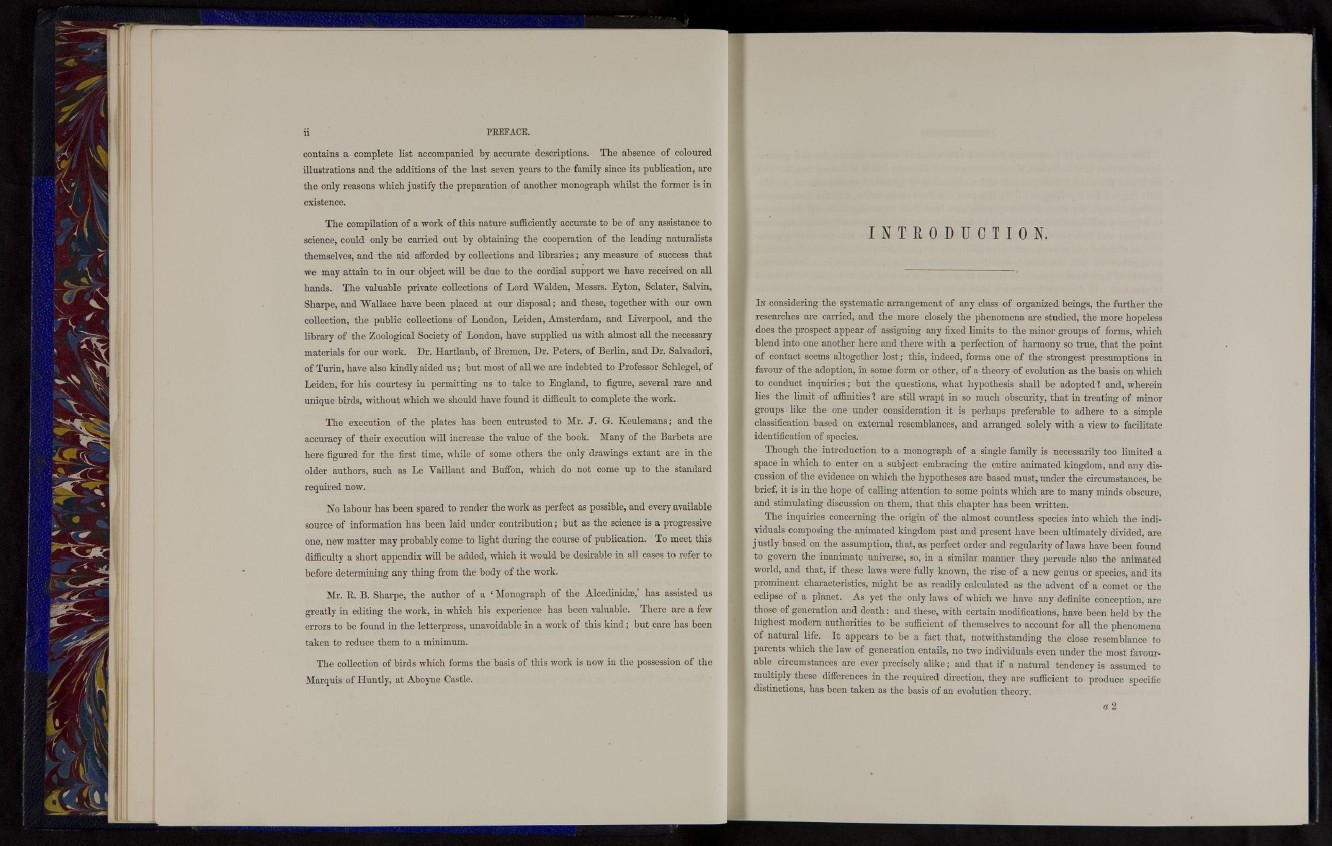
ii PREFACE.
contains a complete list accompanied by accurate descriptions. The absence of coloured
illustrations and the additions of the last seven years t o the family since its publication, are
the only reasons which justify the preparation of another monograph whilst t h e former is in
existence.
The compilation of a work of this nature sufficiently accurate to be of any assistance to
science, could only b e carried out by obtaining t h e cooperation of t h e leading naturalists
themselves, and the aid afforded by collections and libraries; any measure of success that
we may attain to in our object will be due to the cordial support we have received on all
hands. The valuable private collections of Lord Walden, Messrs. Eyton, Sclater, Salvin,
Sharpe, and Wallace have been placed at our disposal; and these, together with our own
collection, the public collections of London, Leiden, Amsterdam, and Liverpool, and the
library of the Zoological Society of London, have supplied us with almost all the necessary
materials for our work. Dr. Hartlaub, of Bremen, Dr. Peters, of Berlin, and Dr. Salvadori,
of Turin, have also kindly aided u s ; but most of all we are indebted to Professor Schlegcl, of
Leiden, for his courtesy in permitting us to take to England, to figure, several rare and
unique birds, without which we should have found it difficult to complete the work.
The execution of the plates has been entrusted to Mr. J. G. Keulemans; and the
accuracy of their execution will increase the value of the book. Many of the Barbets are
here figured for the first time, while of some others the only drawings extant are in the
older authors, such as Le Vaillant and Buffon, which do not come up to the standard
required now.
No labour has been spared to render the work as perfect as possible, and every available
source of information has been laid under contribution; but as the science is a progressive
one, new matter may probably come to light during the course of publication. To meet this
difficulty a short appendix will be added, which it would be desirable in all cases to refer to
before determining any t h i n g from the body of the work.
Mr. It. B. Sharpe, the author of a ' Monograph of the Alcedinidaj,' has assisted us
greatly in editing the work, in which his experience has been valuable. There are a few
errors to be found in the letterpress, unavoidable in a work of this kind; but care has been
taken to reduce them to a minimum.
The collection of birds which forms t h e basis of this work is now in t h e possession of the
Marquis of I l u n t l y , at Aboyne Castle.
I N T R O D U C T I O N .
IN considering the systematic arrangement of any class of organized beings, the further the
researches are carried, and the more closely t h e phenomena are studied, t h e more hopeless
does the prospect appear of assigning any fixed limits to the minor groups of forms, which
blend into one another here and there with a perfection of harmony so true, t h a t t h e point
of contact seems altogether lost; this, indeed, forms one of the strongest presumptions in
favour of t h e adoption, in some form or other, of a theory of evolution as t h e basis on which
to conduct inquiries; but the questions, what hypothesis shall be adopted ] and, wherein
lies the limit of affinities ? are still wrapt in so much obscurity, t h a t in treating of minor
groups like the one under consideration it is perhaps preferable to adhere to a simple
classification based on external resemblances, and arranged solely with a view t o facilitate
identification of species.
Though the introduction to a monograph of a single family is necessarily too limited a
space in which to enter on a subject embracing the entire animated kingdom, and any discussion
of t h e evidence on which the hypotheses are based must, under t h e circumstances, be
brief, it is in the hope of calling attention to some points which are to many minds obscure,
and stimulating discussion on them, that this chapter has been written.
The inquiries concerning the origin of the almost countless species into which the individuals
composing t h e animated kingdom past and present have been ultimately divided, are
j u s t l y based on the assumption, that, as perfect order and regularity of laws have been found
to govern the inanimate universe, so, in a similar manner they pervade also the animated
world, and that, if these laws were fully known, the rise of a new genus or species, and its
prominent characteristics, might be as readily calculated as the advent of a comet or the
eclipse of a planet. As yet the only laws of which we have any definite conception, are
those of generation and death: and these, with certain modifications, have been held by the
highest modern authorities to be sufficient of themselves to account for all the phenomena
of natural life. It appears to be a fact that, notwithstanding the close resemblance to
parents which the law of generation entails, no two individuals even under the most favourable
circumstances are ever precisely alike; and that if a natural tendency is assumed to
multiply these differences in the required direction, they arc sufficient to produce specific
distinctions, has been taken as t h e basis of an evolution theory.
a 2